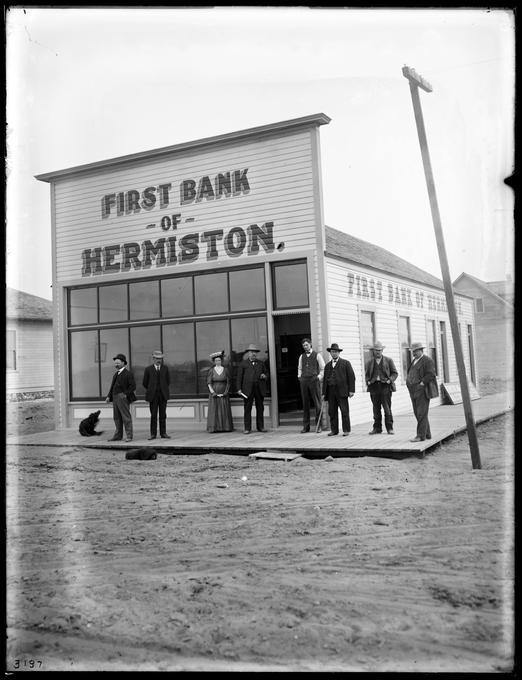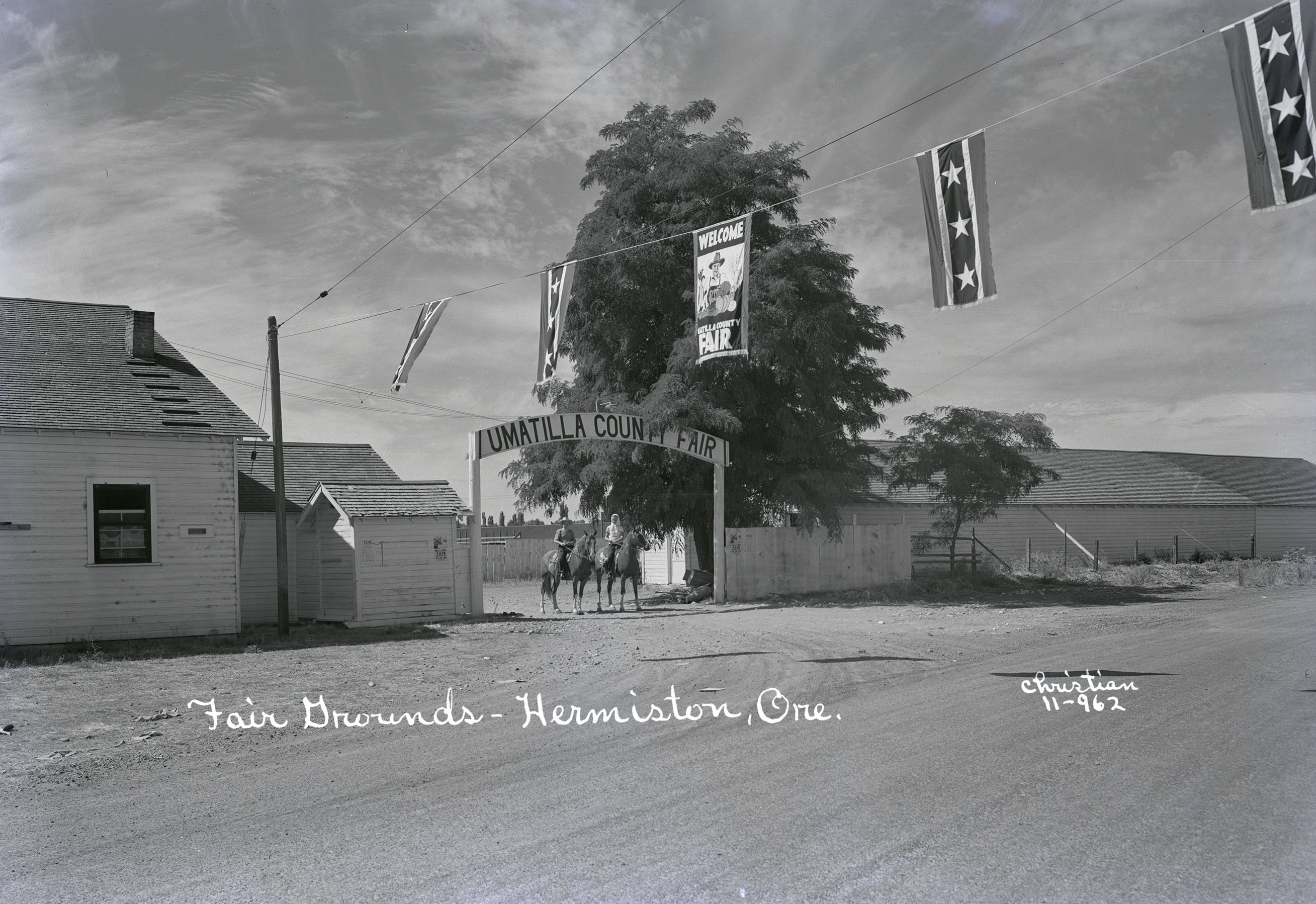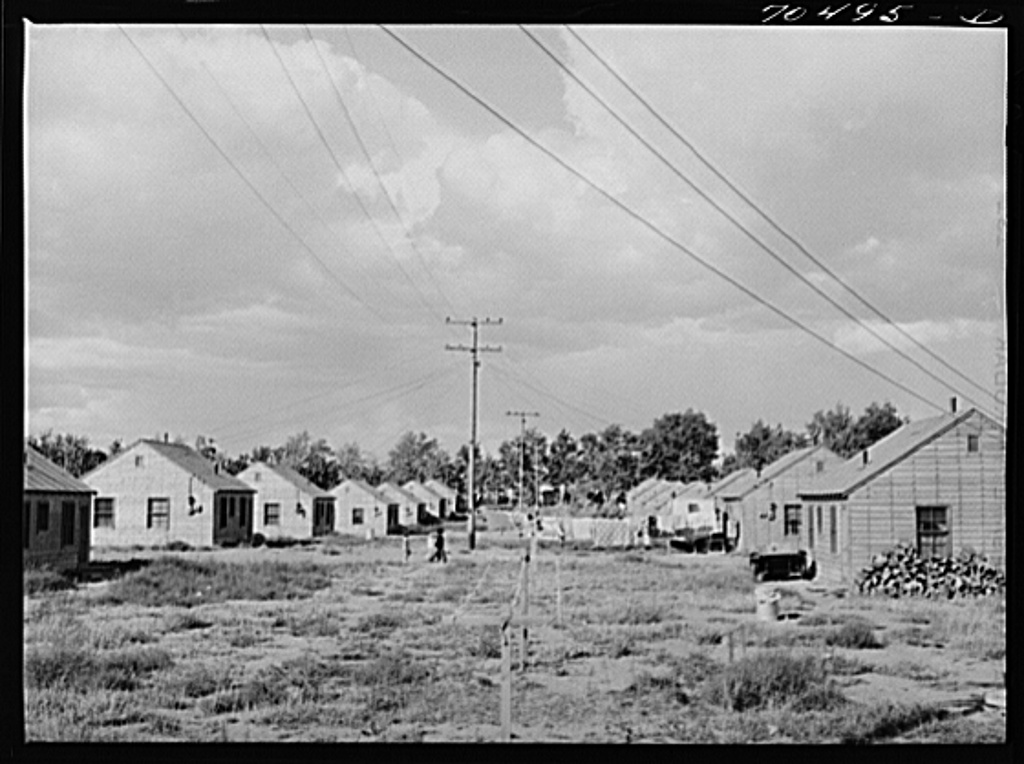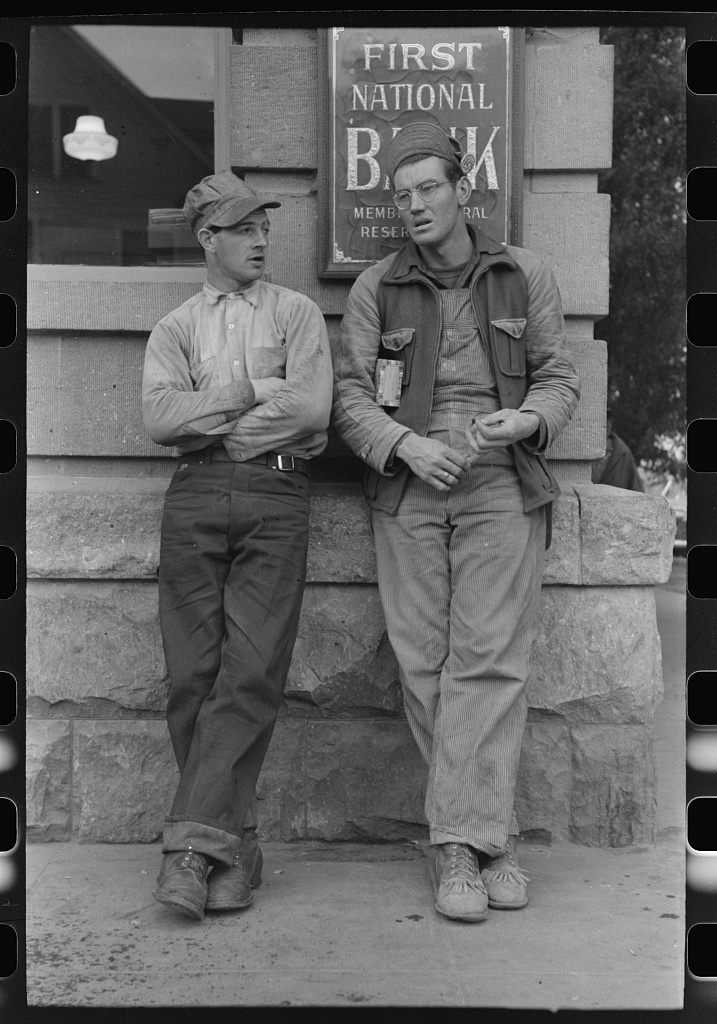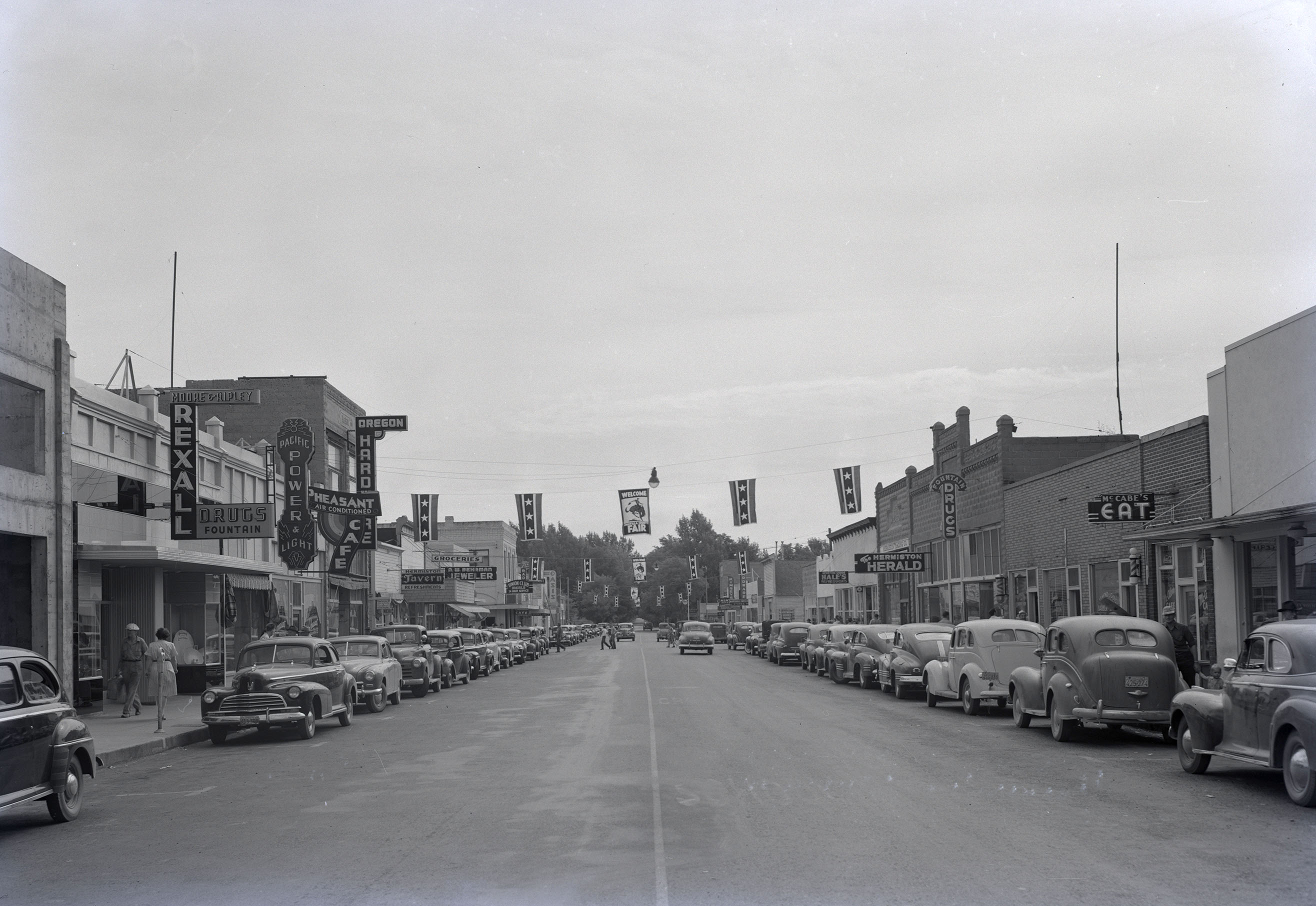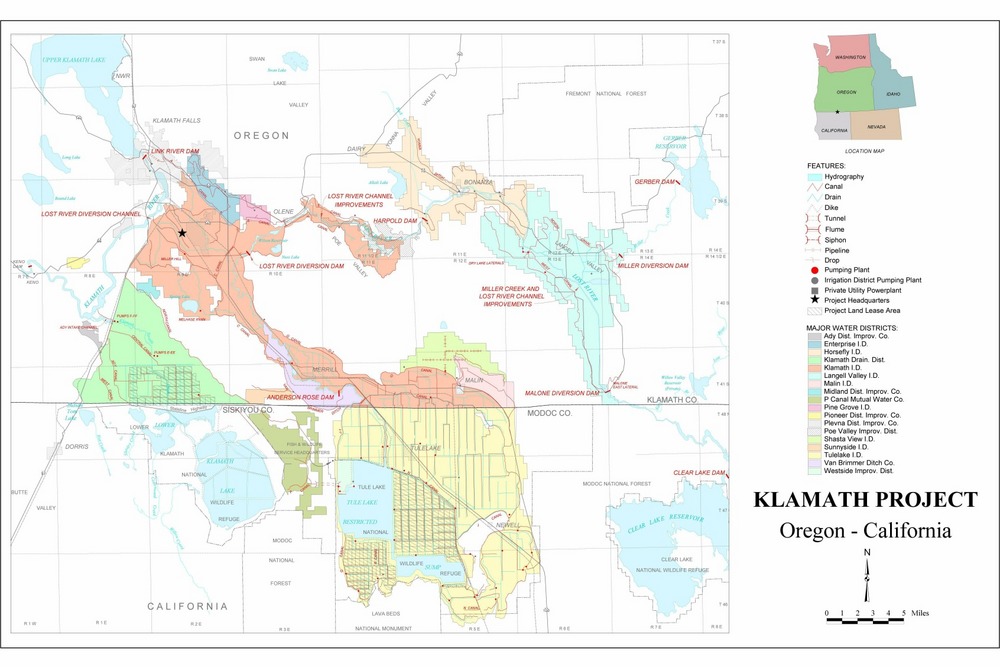At the turn of the twentieth century, the area that would become Hermiston was a hilly, sagebrush-covered desert, but boosters in Pendleton, about thirty miles to the southeast, believed the land could be transformed. The 1902 Reclamation Act was funding irrigation projects in the West, and Horace Greely Skinner and William Newport filed a forty-acre town site plat in 1904. J. F. McNaught named the town Hermiston at the suggestion of his wife Jennie, after Robert Louis Stevenson’s 1896 unfinished novel Weir of Hermiston.
Hermiston is on the homelands of the Cayuse, Umatilla, and Walla Walla. When the Confederated Tribes of the Umatilla Indian Reservation was created in 1855 at the Walla Walla Treaty Council, those tribes were restricted to land east of Pendleton. Hermiston developed on the lands the tribes ceded through the treaty, and the town grew rapidly and was incorporated in 1907. Between 1906 and 1908, the federal government built the first part of the Umatilla Irrigation Project, based in Hermiston. The project diverted water from the Umatilla River to fields in northern Umatilla County, and farmers shipped wheat, peas, and potatoes to Portland by rail and riverboat. But the sandy, porous soils proved difficult to irrigate, and drought and cutbacks in federal funding caused Hermiston’s population to plateau. By 1940, the town had a population of 803, basically unchanged from thirty years earlier.
Hermiston got a boost in 1941 when the federal government selected a site eight miles to the west for the Umatilla Army Depot. The location was chosen for its rail connections and interior location, which made it a difficult target for enemy aircraft. More than seven thousand workers moved to the Hermiston area to build UAD, which had 1,001 concrete buildings to store munitions, from .30 caliber small-arms ammunition to two-ton blockbuster bombs. In 1947, seven miles to the north, the Corps of Engineers started constructing McNary Dam on the Columbia River, which boosted electricity and water in the region. Because of the dam and the depot, Hermiston’s population jumped to 3,804 by 1950.
By the 1980s, reports of nerve gas leaking from the storage facility at UAD led Congress to order the elimination of the nation’s aging chemical weapons. The plan to decommission UAD proceeded slowly, but by 2004 fear of a terrorist attack combined with concerns about a major earthquake prompted the U.S. Army to begin incinerating chemical weapons stored at the site. Some Hermiston residents filed federal lawsuits to stop the incineration, and dozens of construction workers filed a lawsuit in federal court alleging they had become violently ill while constructing the incinerator. Nevertheless, the army continued the process, finishing in October 2011.
Although wheat and weapons dominated the headlines about Hermiston, the development of center-pivot irrigation wells in the early 1970s changed residents’ lives by making 100,000 acres of land near the city a prime location for crops. The area's potatoes became McDonald’s french fries, River Point Farms supplied Subway with 70 percent of its red onions, and Lamb Weston and J. R. Simplot employed thousands in potato-processing plants. But it was Hermiston’s watermelons that were the most impressive. Hot summer days and cool nights yielded sweet melons, which were aggressively marketed by local boosters eager to divert attention from UAD’s looming presence. Hermiston also became a transportation hub with the construction of the Umatilla Bridge over the Columbia River in 1955 and two interstate highways—I-82 in 1957 and I-84 in 1975—that intersect southwest of the city.
Hermiston continues to grapple with water scarcity and the legacy of water rights treaties. After Oregon became a state in 1859, it granted water from the Umatilla River to resettlers for irrigation, ignoring Cayuse, Umatilla, and Walla Walla tribal water claims. The dams and canals that were subsequently constructed caused salmon and steelhead runs to disappear, and the trickle-down effect hampered the Native fishing economy. The tribes had never legally given up rights to the water, and a lack of clarity from the federal government about whether or not it would allow tribes to have rights to their water created decades of uncertainty. In 1988, the Umatilla Basin Project permitted a restoration of salmon and steelhead runs as part of a water exchange program that also allowed Hermiston and other communities to get the water they needed. The project allowed the Bureau of Reclamation to build a pump-and-canal scheme to get Columbia River water to irrigation districts, leaving Umatilla River water for Native fishing and allowing for fish-passage facilities through the river’s five dams. By the late 2000s, as many as fifteen thousand salmon and steelhead returned to the basin each year.
By 2010, Hermiston surpassed Pendleton to become the largest city in eastern Oregon. Much of its growth stemmed from an increase in the number of Latino residents. During the twentieth century, Latino immigrants from a variety of countries, mainly young men seeking agricultural work, moved to Hermiston. In the twenty-first century, the newcomers were mostly U.S.-born Latino families of Mexican descent. In 2012, the city established a Hispanic Advisory Committee to disseminate information and to give Latinos a voice in the community. Two of Hermiston’s eight city council members were Latinos. By 2018, 54 percent of Hermiston School District students identified as Hispanic or Latino.
Early in 2019, the Union Pacific Railroad ceased most local operations in Hermiston, creating hundreds of job losses and causing concern about the city's economic future. Oregon Senators Jeff Merkley and Ron Wyden feared that the layoffs would “devastate" Hermiston by "hamstringing the economic opportunities and stability of the entire region.” The city offered services for families that had lost their income and hosted an emergency job fair to encourage people to stay in the community. Despite the challenges, Hermiston remained the largest city in northeast Oregon, with an estimated 19,696 residents in July 2021.
-
![]()
First Bank of Hermiston.
Courtesy University of Oregon Libraries -
![]()
Hermiston watermelons, 1955.
Oregon Historical Society Research Library, OrgLot1284_2522_2 -
![]()
Early Hermiston, Oregon.
Courtesy University of Oregon Libraries -
![]()
Hermiston, 1907.
Courtesy University of Oregon Libraries -
![]()
Landscape near the Hermiston Experiment Station, c.1910.
Courtesy Oregon State University Libraries -
![]()
Hermiston fair grounds.
Oregon Historical Society Research Library, OrgLot1275_B1_Christian_11-962 -
![]()
Aerial of Hermiston Blocks 2-5 at depot, 1941.
Courtesy Library of Congress, 8e01634v -
![]()
Contractor-built housing at depot, Hermiston, 1941.
Courtesy Library of Congress, 8c22710v, Russell Lee photographer -
![]()
Depot workers in Hermiston, 1941.
Courtesy Library of Congress, 8a30644v, Russell Lee photographer -
![]()
Hermiston, c.1948.
Oregon Historical Society Research Library, OrgLot1275_B3_Christian_11-964 -
![Hermiston and McNary Dam, July 1963.]()
Hermiston and McNary Dam, Jul 1963.
Hermiston and McNary Dam, July 1963. Photo D.J. Weir, U.S. Bureau of Reclamation, P30-100-940
Related Entries
-
![Latinos in Oregon]()
Latinos in Oregon
The arrival of Latinos in Oregon began with Spanish explorations in the…
-
![National Reclamation Act (1902)]()
National Reclamation Act (1902)
When Congress passed the National Reclamation Act in 1902, the measure …
-
![Umatilla Army Depot]()
Umatilla Army Depot
In 1940, the U.S. Army identified twenty thousand acres straddling the …
-
![Umatilla River]()
Umatilla River
The Umatilla River flows out of the forested northwestern slopes of the…
-
![U.S. Bureau of Reclamation]()
U.S. Bureau of Reclamation
The U.S. Bureau of Reclamation, in the Department of the Interior, has …
Related Historical Records
Map This on the Oregon History WayFinder
The Oregon History Wayfinder is an interactive map that identifies significant places, people, and events in Oregon history.
Further Reading
Barbee, Sam. “Hermiston and Watermelons: Branding and History.” Hermiston Herald, March 30, 2016.
Caldwell, Earl. “A Town Is Proud Of Its Gas Depot.” New York Times, December 30, 1969.
Cleveland, Nina Rae. “Hermiston Cooperative Laundry and Cannery, 1928-1954: In a Burst of Steam.” Pioneer Trails 26.1 (Spring 2002): 11-22.
Eddy, David. “Magic Melons.” American Vegetable Grower 57.5 (May 2009).
Flacus, Gillian. “Town Wary of Army’s Incineration Plans.” Washington Post, October 26, 2003.
Frink, Jayne T. “E.P. Dodd: His Dreams Came True.” Pioneer Trails 20.2 (Summer 1996): 3-8.
Hiers, Rebecca H. “Leadership From The Heart: One Tribe’s Example.” Journal of Law and Religion 26.2 (2010-2011): 541-583
McDowell, Jade. “As its Latino Population Grows, Hermiston Embraces the Label of ‘Inclusive Community.’”The Other Oregon, December 27, 2019.
Murphy, Kim. “Weapons Go Up in Smoke.” Los Angeles Times, October 27, 2011.

